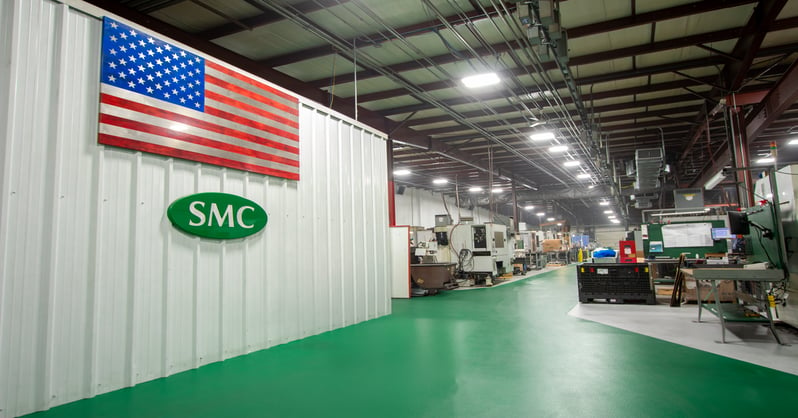Disruption. It’s become a familiar word in the manufacturing industry. Whether it’s lingering effects of the pandemic or looming threats of tariffs and political uncertainty, original equipment manufacturers (OEMs) are looking in their own backyards to mitigate risks.
When surveyed, 30% of manufacturers have reshored to the U.S. over the last ten years or are actively executing reshoring strategies. Another 16% are considering it, according to the 2025 Reshoring Survey.
Reshoring Machining Is More Than Cost. It’s About Control.
When asked which factors went into the decision to reshore to the U.S., the number one reason wasn’t price or politics. Instead, 41% of OEMs placed the highest priority on long-term sustainability. Several factors play into that.
Reshoring isn’t just about bringing manufacturing closer, but about regaining control. By partnering with a domestic supplier, OEMs gain greater confidence in their supply chain, ensuring operations stay on track even amid global disruptions.
Quality assurance also improves through hands-on collaboration and clear communication, reducing the risk of costly surprises. And, with shorter lead times and faster turnaround, customers get to market faster and respond to changes with confidence.
Many who initially sought offshore production did so for perceived per-piece cost savings. However, the “total cost of ownership” perspective has been enlightening for many. Perceived savings can easily be eroded by poor quality, nonconformance, extensive lead times, and transport costs.
Organizations are increasingly recognizing reasons for reshoring beyond price. According to the survey respondents, these were among the top reasons for reshoring:
-
45% - Having manufacturing located near engineering
-
45% - Reduction in freight and duty costs
-
38% - Potential geopolitical risk
-
28% - Supply chain disruptions
-
17% - Image/brand of “Made in USA”
Why Proximity to a Vendor-Partner Matters More Than Ever
When OEMs reshore production, they have a powerful advantage: direct, face-to-face collaboration with their machining partner. At Stecker Machine, being close to customers enables faster, more effective problem-solving. Whether it’s reviewing a prototype, troubleshooting a quality concern, or refining a part’s design, in-person interaction means less back-and-forth and faster progress.
On-site visits build trust and accountability, giving customers clear visibility into production processes and project milestones. They also create opportunities for real-time iteration with Stecker’s integrated teams. Engineering, quality, and production all work together under one roof. That collaboration accelerates development cycles and eliminates costly delays. No more waiting days for overseas emails or international sample shipments.
And, thanks to in-house tooling and close foundry partnerships, Stecker streamlines every stage of production, from initial design to final delivery.
RELATED ARTICLE: The Power of Partnership in Complex CNC Machining
Solving Complex Machining Others Won’t Touch
A major reason OEMs consider reshoring is quality assurance. Offshoring commodity parts that require low tolerances and simplistic designs is one thing, but highly complex components are another.
At Stecker Machine, we’ve delivered intricately designed OEM parts with major GD&T challenges and helped redesign components for improved manufacturability, all while maintaining critical dimensional accuracy. Our engineering team doesn’t just follow a print; we evaluate the intent behind it, looking for ways to enhance both function and efficiency. If a part calls for ±0.0005” tolerances or flatness across complex geometries, our team knows how to develop a repeatable process and design fixtures to make it happen.
One example is a complex transmission channel plate project. When multiple CNC shops couldn’t machine to the specifications, the OEM turned to Stecker. We recommended switching from A356 aluminum to lost foam casting. It was an unconventional move that enabled better fixturing and tighter process control. Our team achieved critical flatness tolerances and applied GD&T best practices throughout. To ensure consistent quality and efficiency, we invested in a dedicated robotic cell. Where others walked away, Stecker delivered engineering insight, advanced technology, and a commitment to getting it right.
READ MORE: TIGHT-TOLERANCE SUCCESS STORIES
Stecker’s cross-functional machining, quality assurance, and engineering teams view each project not as a one-off order, but as a long-term partnership. That mindset, combined with robust quality systems, makes us the go-to partner for OEMs with high expectations and no room for compromise.
Reshoring simply makes sense, and 96% of OEMs that have done so were very satisfied or somewhat satisfied with the results. We’re proud to say that Stecker’s customer satisfaction ratings score even higher.
It’s time to bring it home. Check out our helpful guide below outlining additional reasons to work with a highly capable CNC machine shop. Then, let us help you reshore your complex CNC parts with our dedicated engineers and unrivaled workmanship. Contact our team today.



